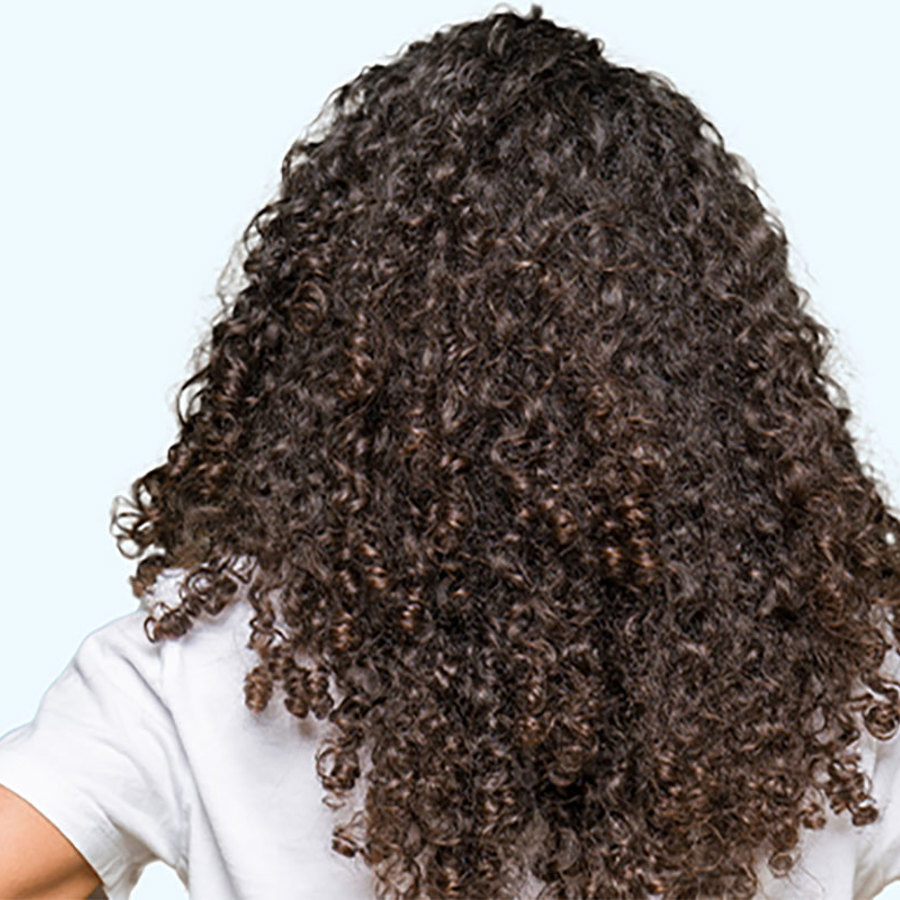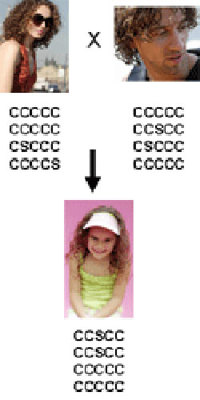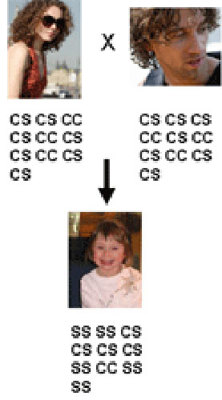
How does curly hair work?
July 9, 2010

- Related Topics:
- Complex traits,
- Hair texture
A curious adult in California asks:
“My husband and I have wavy hair and we have a curly haired son and a son and daughter with straight hair. How does curly hair work?”
Seems like such a simple question. In fact, in the old days it was.
Back then there was a gene that came in two versions, straight and curly. People with straight hair had two copies of the straight version, people with curly hair had two curly versions and people with wavy hair had one of each.
So your case would be pretty easy to explain. You and your husband have one straight and one curly version of the gene which explains your wavy hair. Your curly haired son got a curly version from you and your husband and your other kids got only straight versions from each of you. Simple and neat.
Since then things have become a bit more complicated. It turns out that curly and straight hair are not so easy.
First off, it looks like lots of genes may be involved in making someone's hair straight or curly. Scientists have only found a few so far and none of them has a really big effect. This suggests there are lots more out there waiting to be found.
Second, not everyone has straight or curly hair because of the same genes. People whose ancestors came from Africa have very different curly hair than people whose ancestors came from Europe. And people from Asia have different straight hair than people from Europe. Different genes (and gene versions) are responsible for these different kinds of hair.
So the answer to your question depends on where you and your husband's ancestors came from. And why the two of you have the hair you do.
But still, we should be able to figure something out. In fact, that older, simpler model may still help explain a lot of hair inheritance. We just need to expand it a bit.
From Many, One
Current research definitely points to many genes being involved in making hair straight or curly. In thinking a bit about it though, this shouldn't affect the old model too badly. The new one may even be a bit better...
First, let's deal with people who have ancestors from the same place. In this case, we'll focus on Europeans because they have the widest range of different hair types.
Let's say there are ten genes involved in deciding whether hair is curly, wavy, or straight. Each of these genes comes in a different version, curly or straight. To make the explanation simpler, from now on the curly version will be C and the straight version S.
We're almost ready to work with this new model. But first we need one more bit of information.
Remember, we have two copies of most of our genes, one from mom and one from dad. This means that if we have 10 hair texture genes, we'd each have 20 C's and S's.
So people with really curly hair have mostly C's and people with straight hair have mostly S's. People with wavy hair have some of each.
If two people with straight hair have a child, then they'll usually have straight-haired kids. This is because the parents will have mostly S's to give. Same thing with curly hair (except of course the parents with curly hair would have curly haired kids because they mostly have C's to give). I've shown an example of two curly haired parents having a curly haired child below.
 Wavy hair would work the same way. Most of the time kids would get some S's and some C's from their parents and end up with wavy hair. Sometimes they'd get fewer C's and end up with straighter hair and sometimes they'd get fewer S's and end up with curlier hair.
Wavy hair would work the same way. Most of the time kids would get some S's and some C's from their parents and end up with wavy hair. Sometimes they'd get fewer C's and end up with straighter hair and sometimes they'd get fewer S's and end up with curlier hair.
In one way at least, this model works better than the old one. It can give us some idea about how different amounts of waviness can happen. Now if we only had more real genes to include!
This model could even explain how curly haired parents sometimes have a straight haired child and vice versa. This has to do with the fact that not all curly hair genes are created equal. And with the fact that curly hair is sometimes just very wavy and straight hair sometimes very unwavy.
From Curly, Straight
Up until now I have been implying that all 10 genes have the same effect. In other words, a C from gene 1 is equivalent to a C from gene 10. But this is almost certainly not the case.
For example, a key hair gene in Europeans is called TCHH. A couple of different studies found that different versions of this gene could account for around 6% of hair curliness. The only other gene scientists have found accounts for less. And there are presumably other genes that account for even less.
So imagine the two parents below. Their hair looks very curly but you can see there are some S's scattered through their DNA.

Also note that I have listed the letters in pairs. Each pair represents a single gene. I have also arranged them so that the most powerful genes are first and the least powerful last. So an S in the first pair is way more powerful than an S in the last pair.
Notice that some of the S's these parents have happen to be in the stronger genes. If by chance these parents were to pass on all of their S's to their daughter, then she would have straighter hair. In fact, they may only need to pass the S version of the more powerful hair texture genes to have such a big effect.
This model was able to get a straight haired child from curly haired parents without having to invoke anything too complicated. No need to introduce dominant and recessive gene versions. Or unknown genes turning our hair texture genes on or off. Or something in the environment changing the DNA to cause hair to straighten.
Of course, any of these last things could be happening too. Which is what makes genetics so much fun. There is more than one way to curl a hair!
From Many, ?
The whole previous discussion was about people with ancestors from the same regions. What about people with different ancestors? Say someone with an Asian and a European parent? Or someone with an African and an Asian parent?
This is a lot harder to predict. We don't have any extensive studies yet on what the various hair genes do in different backgrounds.
We don't know, for example, how likely the Asian EDAR gene version is to thicken and straighten hair in someone who is mostly European. Or how likely the European curly TCCH gene version is to add curl in someone who is mostly Asian. That'll have to wait for more studies.
Anecdotally we do know that at least some of these traits tend to blend. For example, children of African and European parents tend to have hair that is in between the two parents' hair texture — sort of softer curls. But we don't know, for example, what effect the curly TCHH gene has in the context of the African curly hair genes.
I am sure that scientists will start to test more people of mixed heritage to try to figure all of this out. Then I'll be able to write more on this part of the subject.

Author: Dr. D. Barry Starr
Barry served as The Tech Geneticist from 2002-2018. He founded Ask-a-Geneticist, answered thousands of questions submitted by people from all around the world, and oversaw and edited all articles published during his tenure. AAG is part of the Stanford at The Tech program, which brings Stanford scientists to The Tech to answer questions for this site, as well as to run science activities with visitors at The Tech Interactive in downtown San Jose.
 Skip Navigation
Skip Navigation
